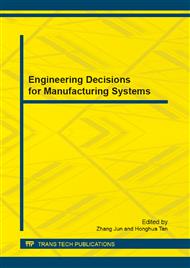[1]
S. srikanth, Joshua U. Turner. Towards a Unified Representation of Mechanical Assemblies, Engineering with Computers. 1990, No. 6: 103~112.
DOI: 10.1007/bf01200242
Google Scholar
[2]
Bourjault. Contribution to a methodological approach of automated assembly In Automation Methocology in Manufacturing Industry, Paris, France. 1985: 12~46.
Google Scholar
[3]
Alfred J.D. Lambert . Generation of assembly graphs by systematic analysis of assembly structures. European Journal of Operational Research. 2006: 932~951.
DOI: 10.1016/j.ejor.2004.07.038
Google Scholar
[4]
Ko H, Lee K. Automatic assembling procedure generation from mating conditions[J]. Computer Aided Design, 1987, 19(1): 3~10.
DOI: 10.1016/0010-4485(87)90146-1
Google Scholar
[5]
Dini G, Santochi M. Automated Sequencing and Subassembly Detection in Assembly Planning , Annals of CIRP. 1992, 41(1): 1~4.
DOI: 10.1016/s0007-8506(07)61140-8
Google Scholar
[6]
A Delchambre. Computer-aided assembly planning. London: CHAPMAN HALL, 1992: 40~60.
Google Scholar
[7]
C. Ke and J.M. Henrioud, Systematic generation of assembly precedence graphs, IEEE International Conference on Robotics and Automation, Vol. 2, San Diego, California U.S. A, May 1994: 1476~1482.
DOI: 10.1109/robot.1994.351282
Google Scholar
[8]
Y.F. Huang and C.S.G. Lee, precedence knowledge in freature mating operation assembly planning. Purdue Univ. Engineering Center, Tech, Rep. TRERC 88~22, May (1989).
Google Scholar
[9]
L.S. Homem de Mello and A.C. Sanderson, A correct and complete algorithm for the generation of mechanical assembly sequences, IEEE Transaction on Robotics and Automation , April, (1991).
DOI: 10.1109/robot.1989.99967
Google Scholar
[10]
Henrioud,J. M and Bourjault , A LEGA: a computer-aided generator of assembly plans. In Computer-Aided Mechanical Assembly Planning(Eds L.S. Homen de Mello and SLee), 1991: 191~216.
DOI: 10.1007/978-1-4615-4038-0_8
Google Scholar
[11]
Henrioud, J, M and Bourjault, Computer aided assembly process planning, Proc. INstn Mech. Engrs, Part B, Journal of Engineering Manufacture, 1992, 206(B1): 61~66.
DOI: 10.1243/pime_proc_1992_206_056_02
Google Scholar
[12]
H.K. Tonshoff,E. Menzel H.S. Park Aknowledge-Based System for Automate Assembly Planning. Annals of the CIRP. 1995, 28: 19~24.
Google Scholar
[13]
A. Delchambre, Computer-aided Assembly Planning , CHAPMAN&HALL.
Google Scholar
[14]
Maria Joao Abrantes, Simon D Hill"Computer-Aided Planning of Mechanical Assembly Sequence", in Faculty of Computing and Information Technology, Department of Robotics and Digital Technology Technical Report 95-7, Monash University Clayt.
Google Scholar
[15]
Guan Q, Liu J H, Zhong Y F. A concurrent hierarchical evolution approach to assembly process planning[J]. International Journal of Production Reasearch, 2007, 40(14): 3357-3374.
DOI: 10.1080/00207540210146152
Google Scholar
[16]
Saeid M, et al. Multi-criteria assembly sequencing[J]. Computer Industrial Engineering, 2000, 32(4): 743~751.
Google Scholar
[17]
Romney B., Goddard C. An efficient system for geometric assembly sequence generation and evaluation. Proceedings of the ASME International Computers in Engineering Conference, 1995, 699-712.
DOI: 10.1115/cie1995-0800
Google Scholar


